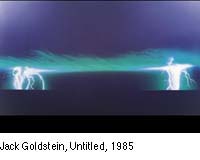
The ghost of Jack Goldstein is haunting New York right now with films, records and paintings at Mitchell-Innes & Nash uptown and paintings from the early '80s at Metro Pictures in Chelsea. His suicide two years ago went practically unnoticed by a contemporary art world deep in debt to him (details: here).
As part of the Pictures exhibition at Artists Space curated by Douglas Crimp in 1977 he was part of a group that included Robert Longo and Sherrie Levine and his career was made except for one tiny fact: he didn't, for the most part, make art that was salable. So he started making paintings in the 'eighties and they're as startling, haunting and beautiful as when they first appeared in galleries.
Uptown at Mitchell-Innes & Nash Gallery there is a kind of shabby elegance that once defined the upper east side galleries when they were carved out of available space instead of being the main purpose of a building. When you see James Rosenquist's F-111 splayed out in the airport size gallery of the newly remodeled MoMA it's hard to visualize it shoehorned into the the tiny parlor of the original Castelli Gallery, pre-Soho.
While it seemed odd at first that Goldstein's films were only being shown uptown instead of in Chelsea once you make the pilgrimage and climb the stairs you realize that the space is much more hospitable to his work than the Chelsea space would have been. Why that is and what's wrong with Chelsea is a subject for another time. For the time being let's just say there is an equivalence in the juxtaposition between early gritty Soho and the clearner white space of its galleries and the opposite relation on Madison Avenue that is an integral part of the work.
Goldstein made very short films -- four minutes was an epic -- involving a number of technical tricks that now seem quite naive in our age of Final Cut Pro. The gallery made the correct decision to show the films as one reel on a noisy projector, the leads to each one intact. The entire reel doesn't take much more than twenty minutes, if that. During that time, though, you discover just how long four minutes can seem when you're watching feathers being dropped one by one onto a chair covered with tar.
During those long minutes you begin to understand how different film is from video and analog from digital. That light glinting off the surface of a table knife is real light projected on the screen. It's eerily glamorous when compared to the backlit dullness of a flatscreen. The noise of the projector is an essential part of the work as is the fact that when the reel is done the poor attendent, who probably wasn't even born when they were made, has to re-thread and rewind the reel then start the process all over again when someone else asks to view it. That, too, seems an essential part of the piece.

The only films I remember seeing thirty years ago was the loop of the MGM lion roaring over and over against a rich red background and the dog barking. The sound of the projector would have been easy to block out back then but now is nearly overwhelming but I can't imagine watching the films without it. In an age when everything will be digitized it's nice to know that some things aren't.